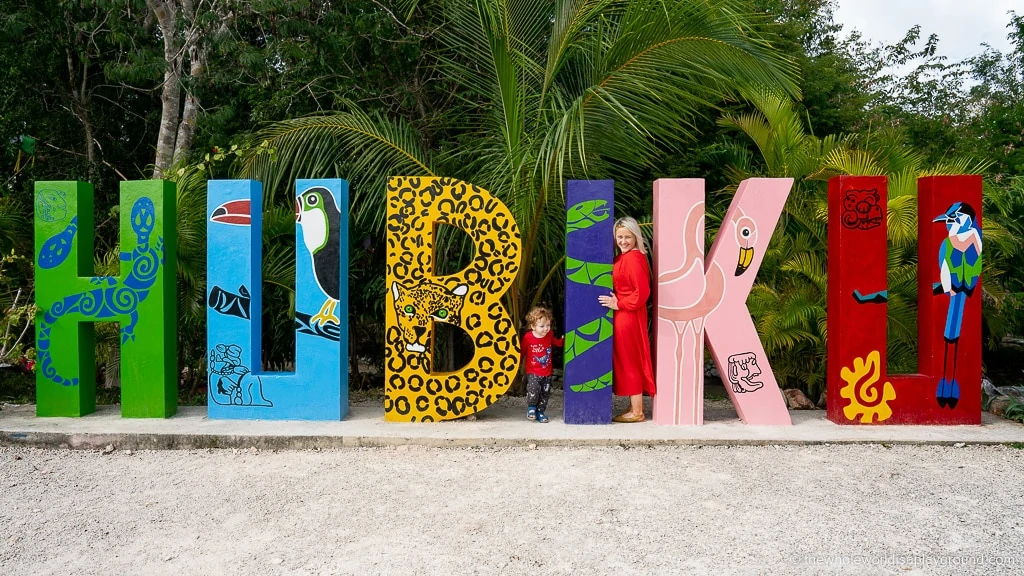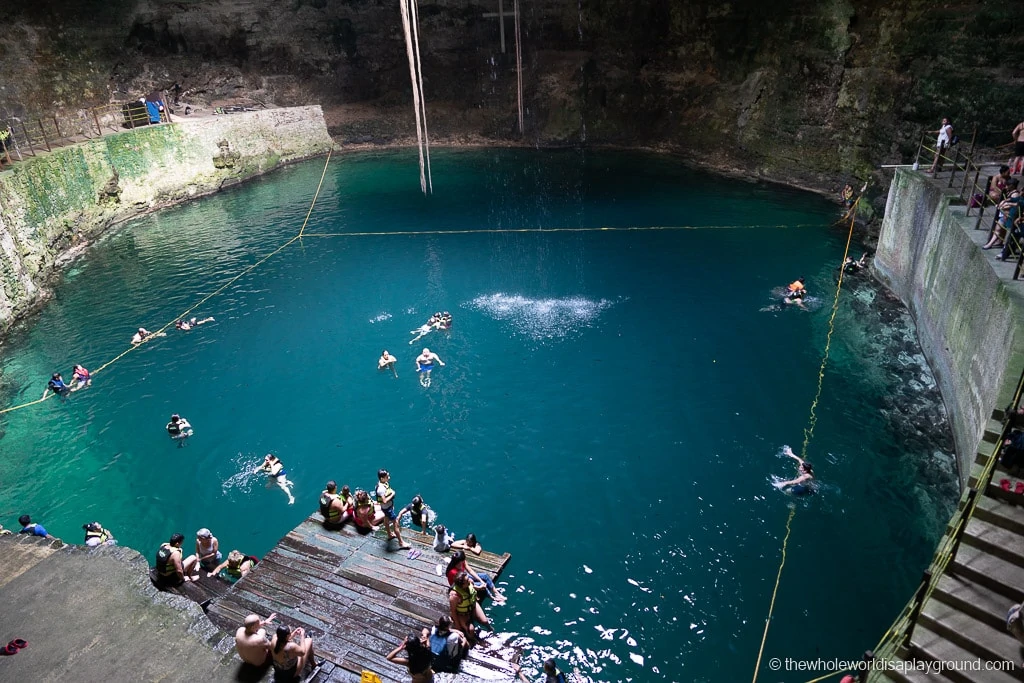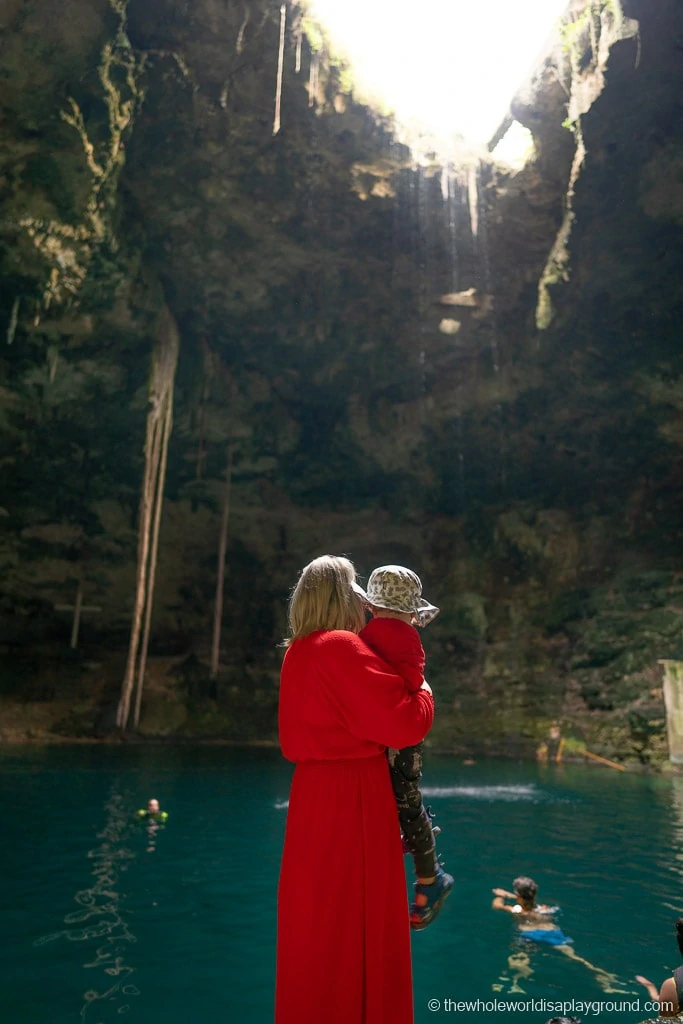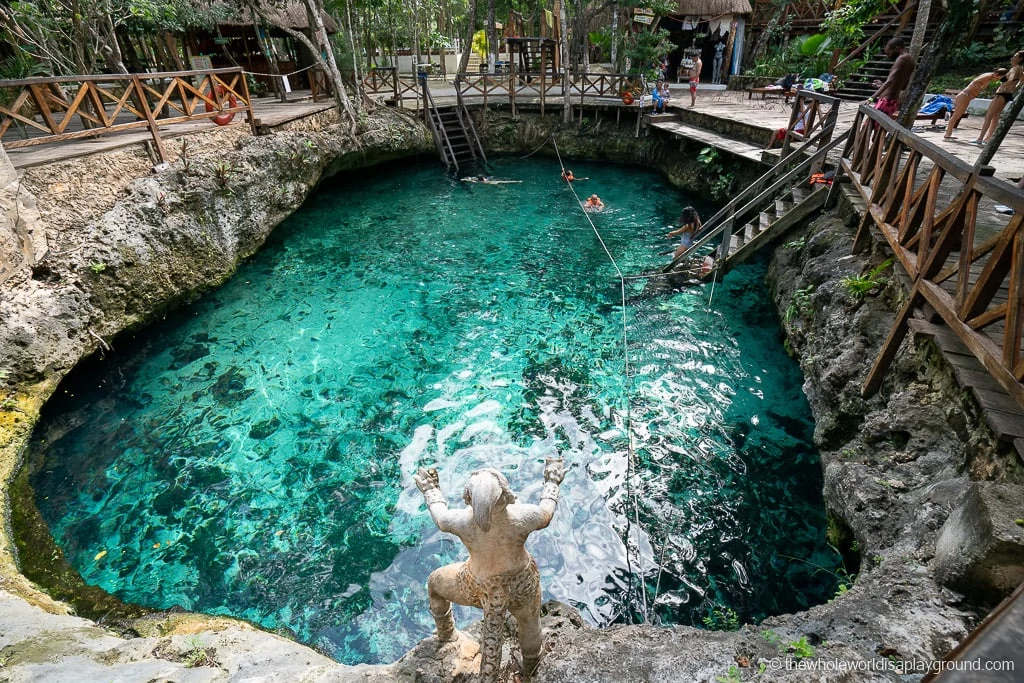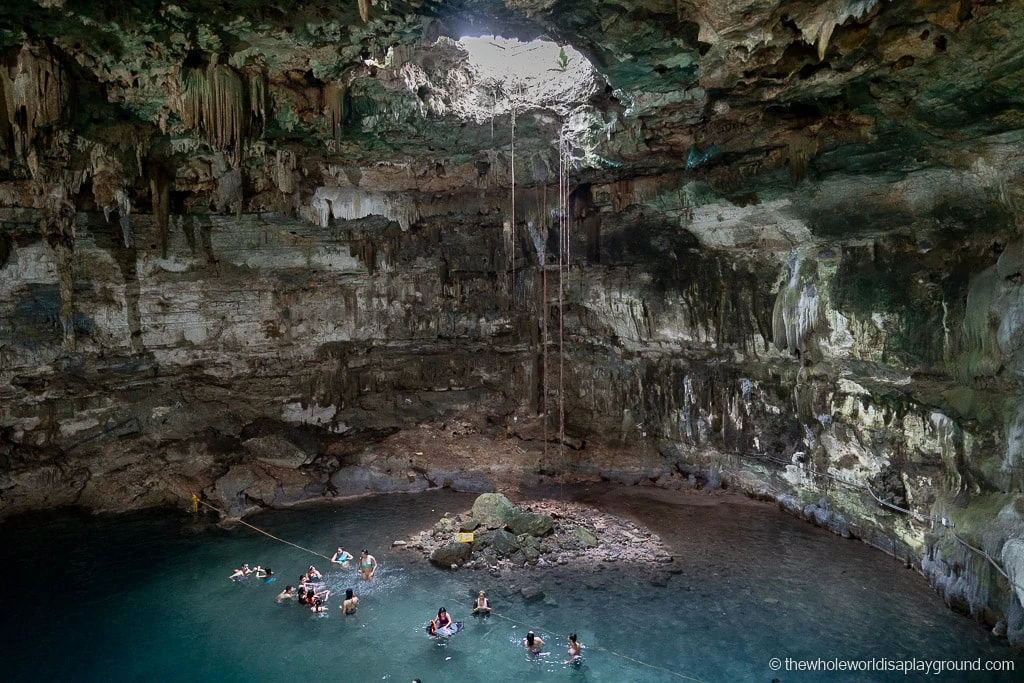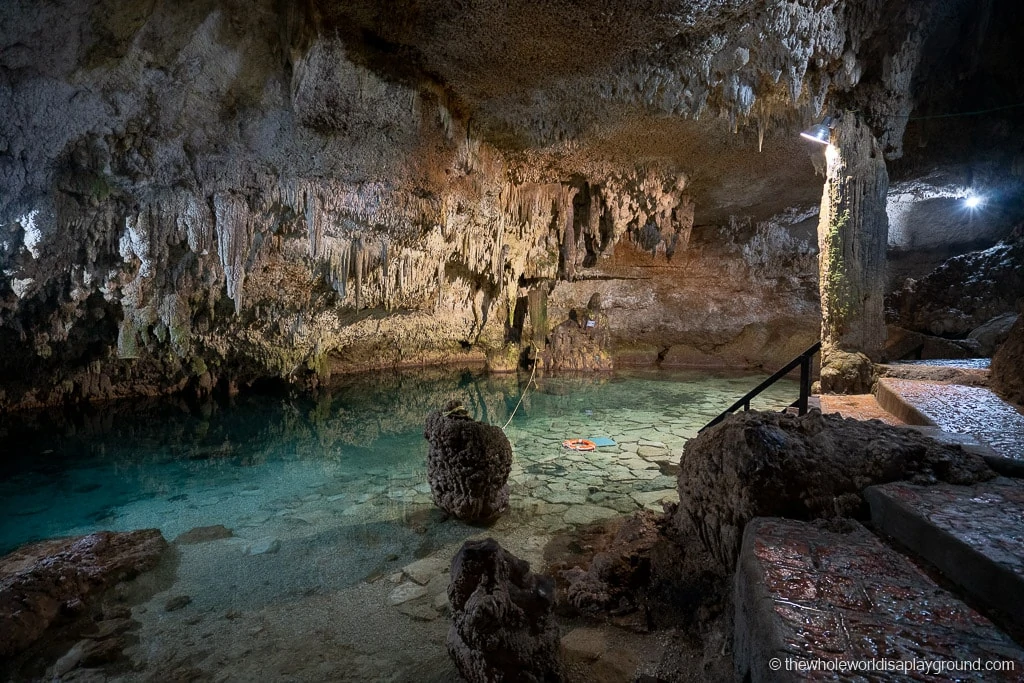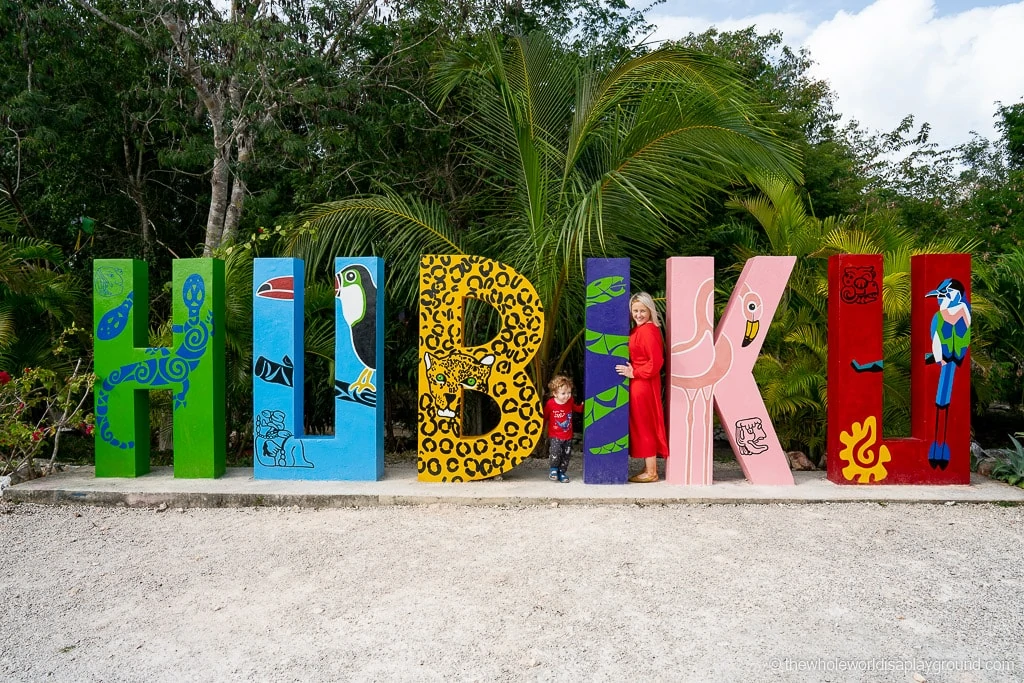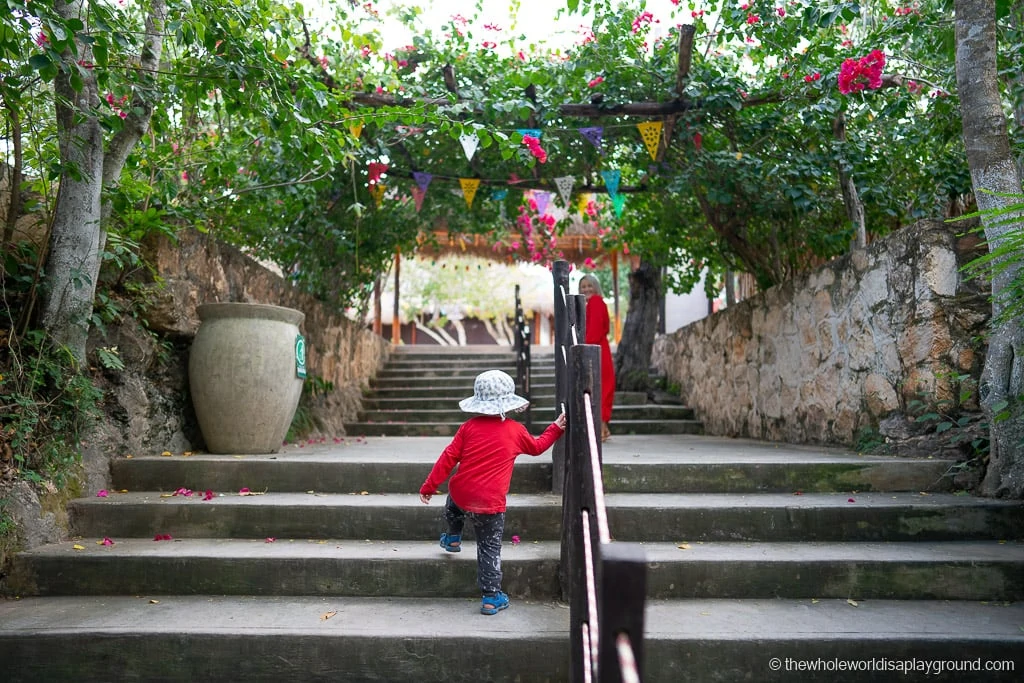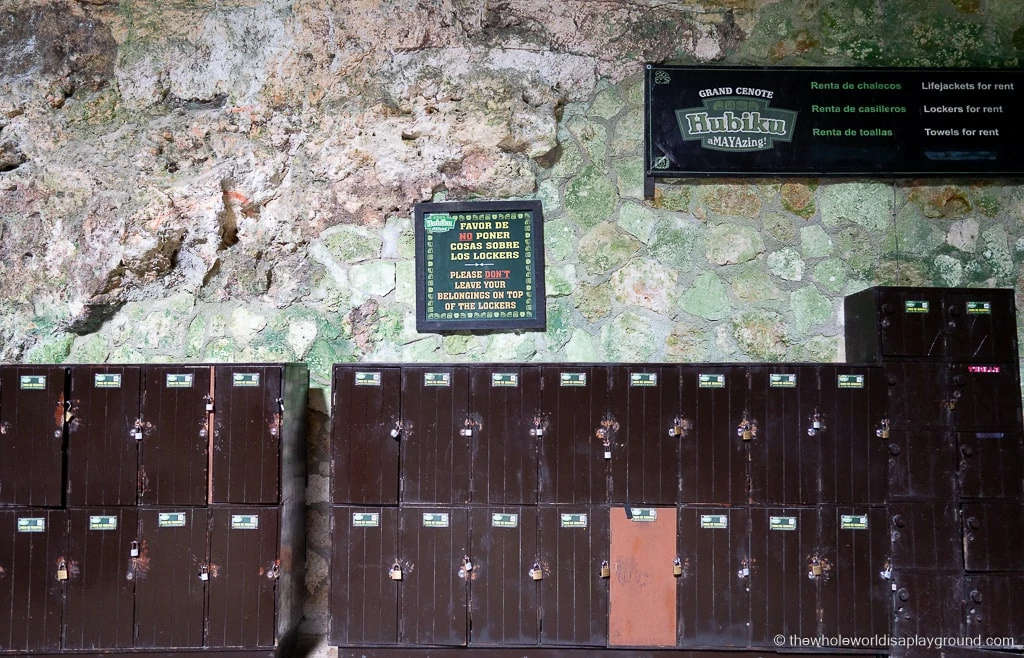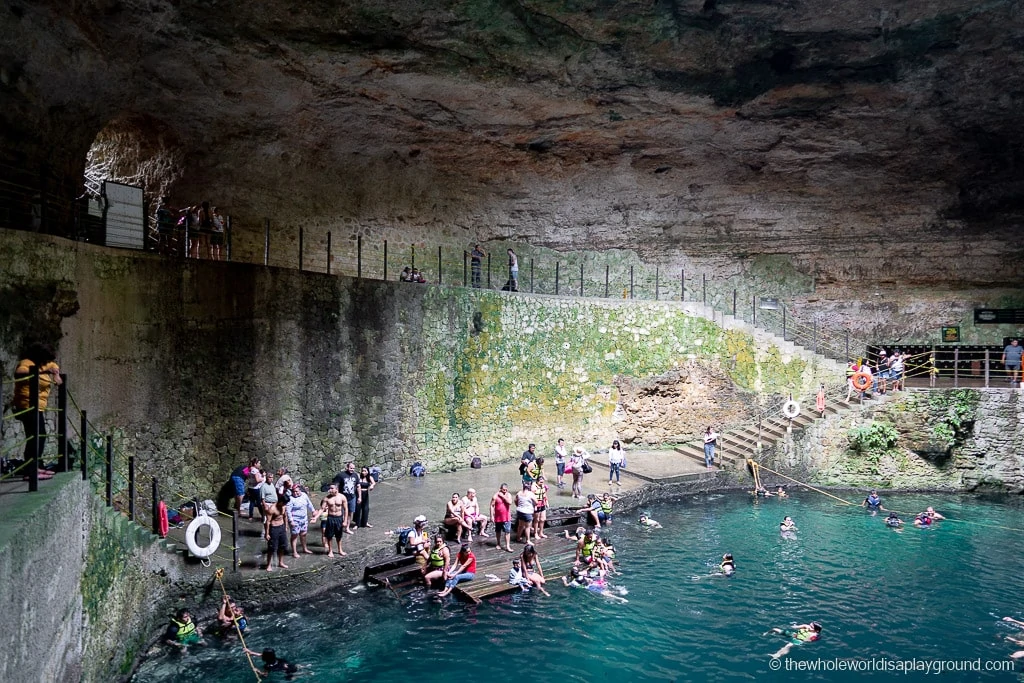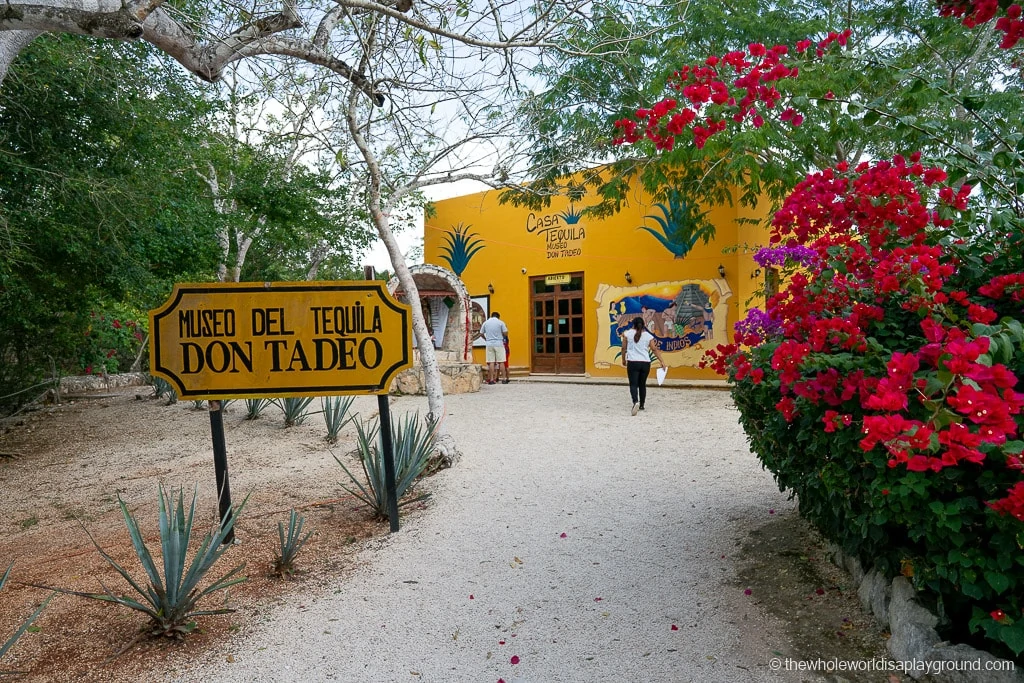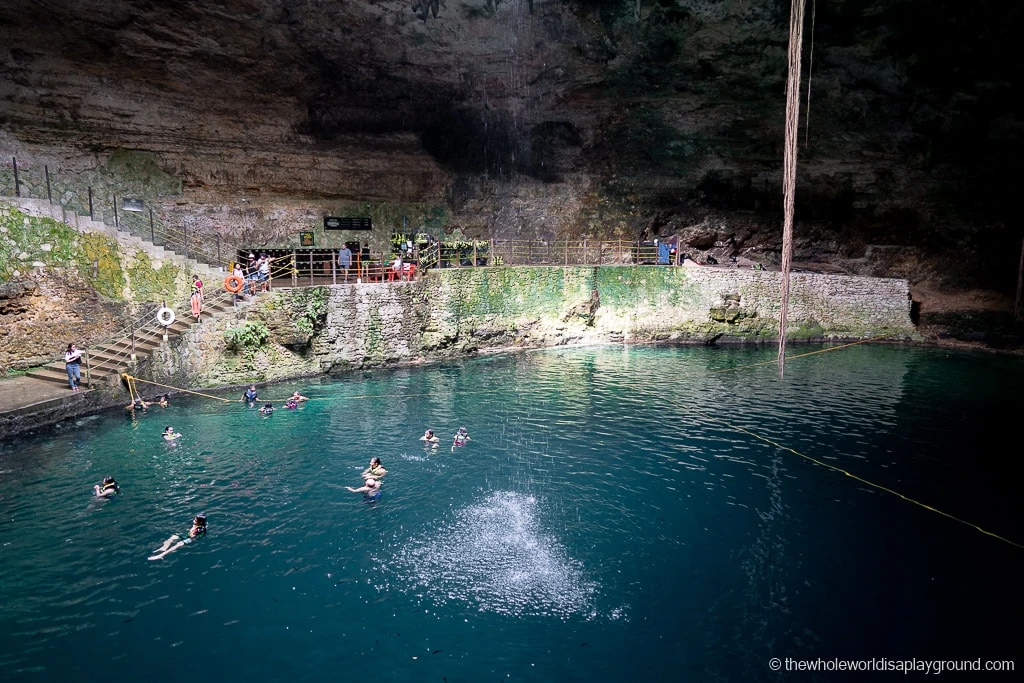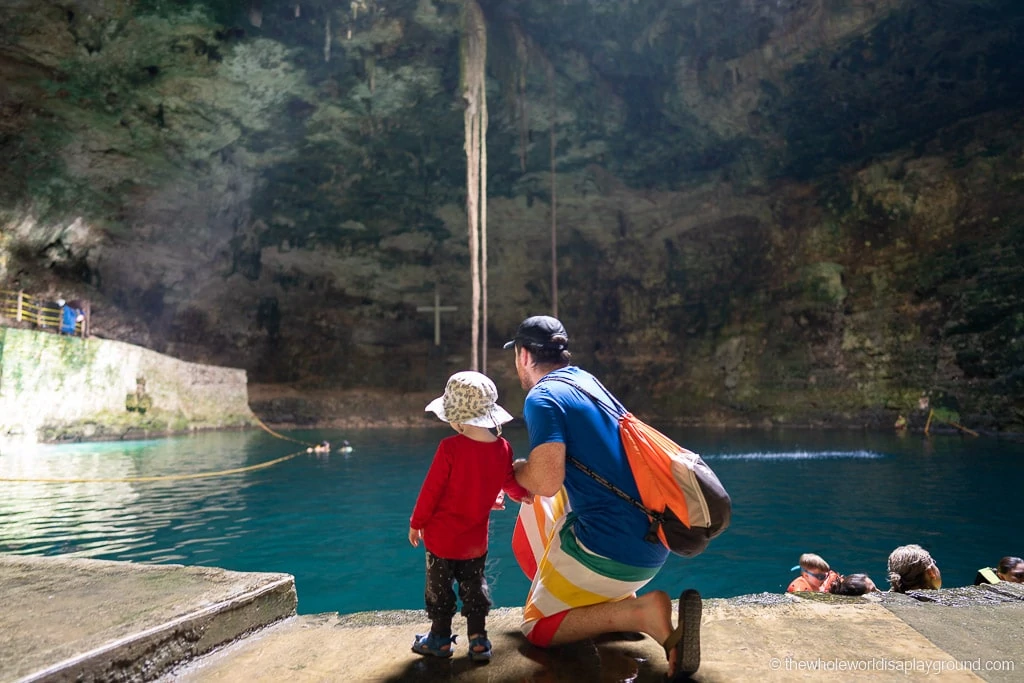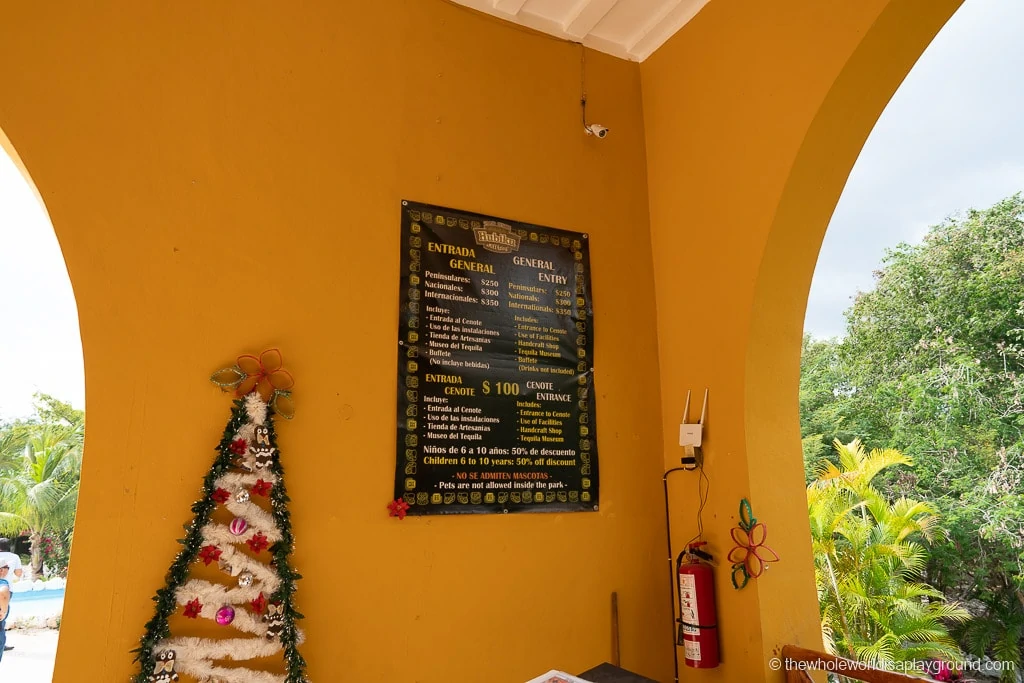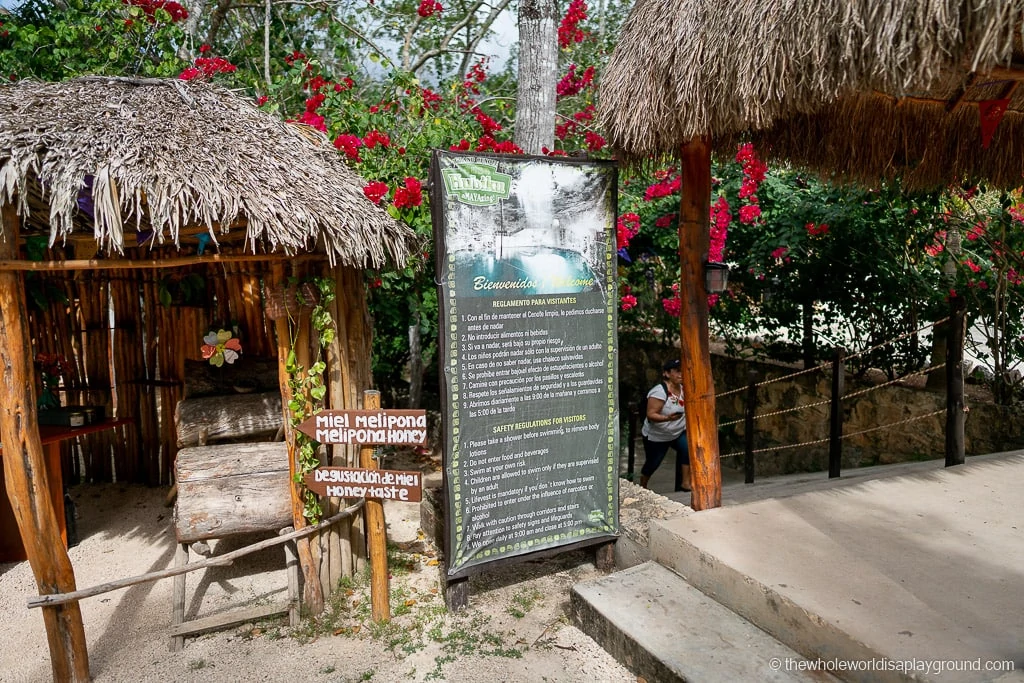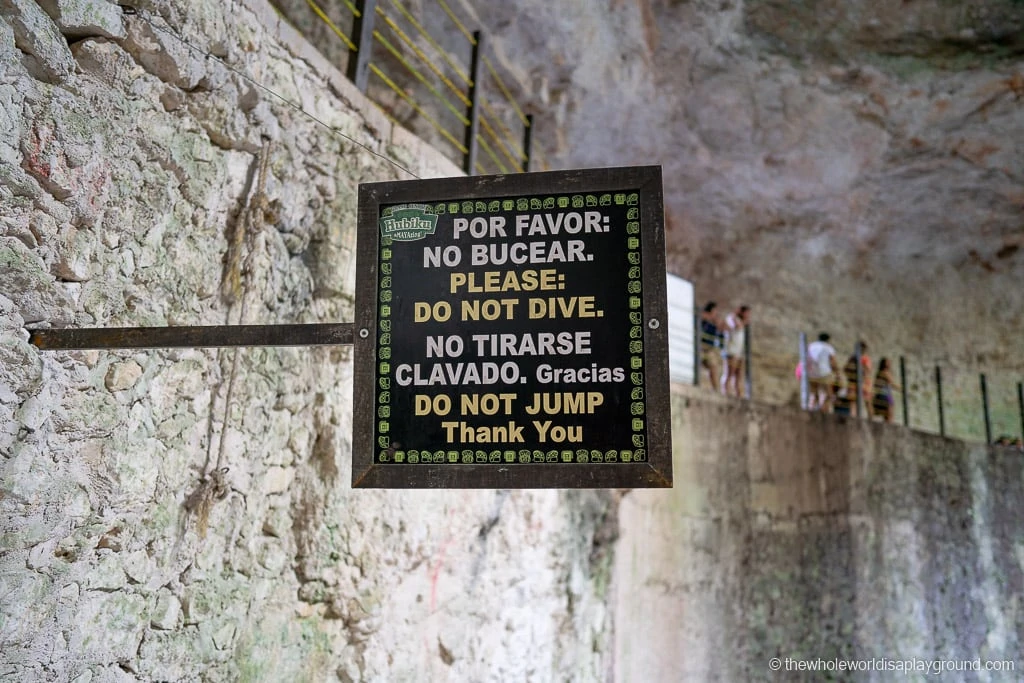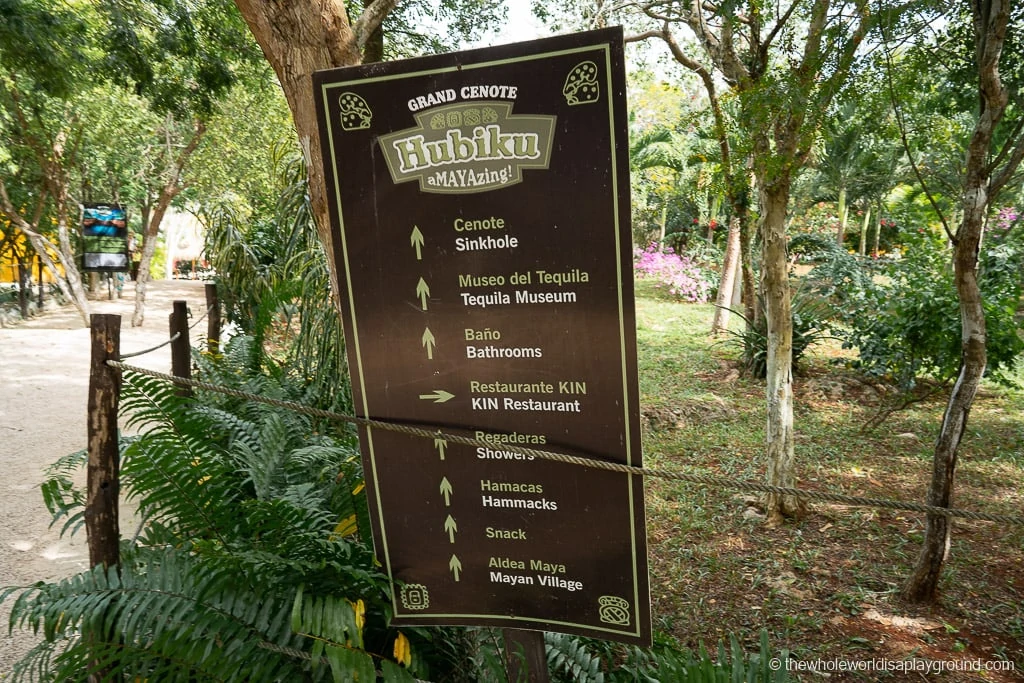Cenote Hubiku is a popular cenote complex located between Valladolid and the Ek Balam ruins. The underground, semi open cenote has an opening in its roof where both natural lights and tree roots cascade towards its waters. Cenote Hubiku is one of the largest we countered on our trip through the Yucatan Peninsula and there’s also a Mayan Village and Tequila Museum to explore while visiting Cenote Hubiku.
Having visited Cenote Hubiku, this is our tips and guide to visiting Cenote Hubiku to help your plan your own visit.
Cenote Hubiku
Cenote Hubiku is an underground cave style cenote with an opening its roof which allows some natural light to illuminate the waters below. Although not as prominent as Cenote Ik Kil at Chichen Itza, there are some vines which hang down into Cenote Hubiku, almost touching the waters below. At times, a small waterfalls cascades through the gap sending a spray of water down into the cenote. Its large swimming area, other on site attractions and family friendly atmosphere mean it is a popular with tour groups and independent visitors alike. In fact, the Maya name Hubiku refers to its vast size and translates to ‘Iguanas Nest’ or ‘the Great Lord’.
The cenote is located in a large complex which encompasses a Tequila Museum, a Mayan Village and a sizable gift shop and restaurant making it easy to spend a morning or afternoon at Cenote Hubiku.
Cenote Hubiku is best for: large groups, families and those wanting a larger space to swim.
What are Cenotes?
A cenote, pronounced seh-NO-tay, are water-filled sinkholes that naturally occur in limestone rock when an underground cave collapses in on itself and exposes the groundwater underneath. There are thousands of cenotes dotted around the Yucatan Peninsula and some of the more scenic ones are extremely popular with locals and tourists alike.
The water in the cenotes tends to be cool as the water comes from underground so they are great for a quick swim to cool off from the hot Mexican sunshine.
In Mayan times a number of the cenotes were used for sacrificial purposes and objects such as gold, pottery and even human and animal remains have been found at the bottom of some cenotes.
The cenotes in the Yucatan Peninsula are a mix of open, semi-open or underground:
Open cenotes: These are caves which have completely collapsed in on themselves and are exposed to the sky. These are our favourite as you can swim in the open air, the water is a pleasant temperature and there are usually lots of areas to relax by the water. Some of our favourite open cenotes are Cenote Azul, Cenote Zacil-Ha and Car Wash Cenote.
Semi-open cenotes: these cenotes are mostly underground but have small openings in the ceiling where light and fresh air come in. These cenotes can be particularly beautiful as the light beams illuminate the crystal clear water below. Our favorite semi-open cenotes were Cenote Suytun, Cenote Ik Kil and Cenote Xkeken.
Underground cenotes: these cenotes are completely underground in a cave system and have no natural light to illuminate the cenote water. These cenotes tend to be more difficult to visit as they are deep in the limestone rock. The three cenotes near the Coba ruins (Multum-Ha, Tamchach-Ha and Choo-Ha) are amazing underground cenotes you can easily visit.
Visiting Cenote Hubiku
Cenote Hubiku is located on the road between Valladolid and the archaeological site of Ek Balam. We visited after a morning spent exploring the incredible Ek Balam ruins and swimming in the Ek Balam Cenote, Cenote X’Canche.
The entrance to the cenote is located adjacent to a large car park in which there is plenty of space for the many buses and cars which bring visitors to Cenote Hubiku. Like many of the cenotes, it is a bit of a bumpy although short drive from the main road to the entrance.
After purchasing tickets, the path to the cenote leads through a large gift shop and some stalls demonstrating Mayan crafts. The changing room and bathrooms are located between the gift shop and the top of the staircase which leads down into Cenote Hubiku.
Cenote Hubiku tip: access to the cenote requires a descent of around 115 steps and the same number to climb on exiting.
The first set of stairs lead to the entrance to the cenote cave. Upon entering the cave, another set of steps lead down to the waters edge. There are some nice views of the cenote from various points at the entrance and during the climb.
Lockers (US $1), towels (US $1) and life jackets (US $2) are available to rent for a fee at locations on the stairway.
At the waters edge, a wooden platform allows for easy access into and out of the cenote and the waters reach almost 27 meters depth. Much of the cenote waters are surrounded by a concrete wall about 20 foot above the water: visitors are not permitted to touch the walls of the cenote and it is not possible to dive or jump from the walls.
Cenote Hubiku tip: the wooden dock is relatively small and can get crowded with less confident swimmers. We prefer to visit at quieter times (early or late in the day) when the cenote is less crowded.
Casa Tadeo, the Tequila Museum
It’s fun to learn about how tequila is made and maybe even indulge in a few tastings at Casa Tedo, Cenote Hubiku’s tequila museum. Entrance to Casa Tadeo is included in the admission.
Mayan Village
The Cenote Hubiku complex houses a small Mayan village with reproductions of the traditional Mayan houses. It’s interesting to explore the ancient style of living in picturesque Mayan houses.
Swimming in Cenote Hubiku
Cenote Hubiku is one of the few cenotes we visited that has active lifeguards on duty at the swimming area. They are also charged with making sure swimmers don’t interfere or touch any of the fragile cenote walls and hanging vines. Due to these understandable rules, once you swim away from the wooden deck you won’t have much to hang onto once you move away from the deck and the yellow guidewire.
The deep and refreshing waters of Cenote Hubiku mean that most people will prefer to wear a life jacket while swimming. David was comfortable enough to swim without one but less confident swimmers should definitely rent one. We realized after that the cool waters of Cenote Hubiku meant we got tired much more quickly that during our swims in the open cenotes where the sun kept us warm.
Cenote Hubiku tip: the cenote was relatively quiet when we visited with not many swimmers in the water. If it was more crowded we would recommend a life jacket to allow for the extra time needed to get out of the water and having very little opportunities to take a break in the water.
One of the best aspects of swimming in cenote Hubiku is the ability to swim directly under the cenote opening – sometimes a small waterfall flows from the rooftop opening. It’s an amazing experience to lie back and look up at the sky from the cenote waters.
Cenote Hubiku tip: Cenote Zaci, the Dztinup cenotes (Cenote Xkeken and Cenote Samula) and Cenote San Lorenzo Oxman are all popular swimming cenotes near Valladolid.
Like most cenotes, there are lots of small fish that often nibble on your legs and feet while you swim. It takes a little getting used to but we soon forgot they were there! Some of the catfish in Cenote Hubiku were a little larger than other cenotes so be aware before you enter the water!
Cenote Hubiku tip: although deep, the waters of Cenote Hubiku are clear enough to see the bottom. It’s fun to rent a snorkel and watch the catfish swim below the surface.
Diving platforms
Diving and jumping are not allowed at Cenote Hubiku and you must enter the water from the wooden deck area by the water. We guess this was to protect both the swimmers and the fragile cenote structures.
Tips for Visiting Cenote Hubiku
1 | How to get to Cenote Hubiku
Rental Car
This is the easiest way to get to all of the cenotes in Mexico. There is a large car park at Cenote Hubiku and it is generally easy to find parking. We rented a car for our time in the Yucatan and highly recommend it to our readers. Renting a car in Cancun was very straightforward and driving was easy. The roads are of good quality, the drivers are nice and the traffic is relatively light – check prices now!
Colectivo (local taxi-buses)
There are colectivo’s which run from Valladolid to Tezomon and Ek Balam – if you plan on taking a colectivo you will need to check with the driver if they stop near Cenote Hubiku.
Taxi
It’s also possible to get a taxi to Cenote Hubiku from Valladolid. The journey takes around 30 minutes.
Tour
Probably the easiest way (aside from a rental car) to visit Cenote Hubiku is as part of a tour to Chichen Itza and Ek Balam. There are a number of tours from Cancun, Playa del Carmen and Tulum that include Cenote Hubiku as part of a day trip itinerary – check prices now!
2 | Cenote Hubiku Cost
Entry to Cenote Hubiku is $100 pesos per person or $350 if you wish to dine at the restaurant buffet. Children between 6 and 10 get half off and children under 6 are free. Ticket prices includes entrance and use of the facilities. Parking is free.
We recommend having cash, preferably Mexican pesos for a better rate, with you when visiting all the cenotes in Mexico. Cenote Hubiku did accept credit cards at the entrance on the day we visited.
3 | Cenote Hubiku Opening Hours
Opening hours: Cenote Hubiku is open from 9 am to 5 pm with last entry around 4:30 pm.
4 | How long to spend at Cenote Hubiku
Cenote Hubiku is a full service cenote with food and drinks available and a buffet restaurant. We spent a few hours at the cenote but it’s easy to spend longer if you prefer.
5 | Best time to visit Cenote Hubiku
Like most cenotes in the Yucatan Peninsula we recommend a morning visit at opening as this is the best way to avoid the crowds.
6 | What’s not allowed in Cenote Hubiku
As we mentioned above, visiting the cenotes is a little different from a traditional swimming pool so there are some different rules to follow when visiting. Cenote Hubiku rules were as follows:
- Showers – You are required to take a shower before you swim
- Alcohol – it’s forbidden to swim if you’ve been drinking alcohol.
- Sunscreen / Mosquito repellent: You are not allowed to wear sunscreen or mosquito repellent before you enter the water at the cenote. This is to preserve the quality of the water for everyone. There are showers available which you have to use before you enter the water.
- Children: Children must be accompanied by an adult when swimming.
7 | Diving platforms
There are no diving or jumping platforms in Cenote Hubiku and diving is not allowed.
Facilities at Cenote Hubiku
Cenote Hubiku is one of the more popular cenotes in the Yucatan peninsula and has everything you need for a chilled few hours.
8 | Changing rooms and lockers
There are changing rooms close to the entrance to the cenote. Lockers and towels are available for US $1
9 | Life jackets
Life jackets are available to rent for US $2 on the way down to the cenote.
10 | Parking
There is a large car park located at the entrance to Cenote Hubiku so parking should not be a problem, even at busy times.
11 | Food and drinks
There are snacks and drinks available close to the entrance to the cenote. There is also a buffet style restaurant on site.
